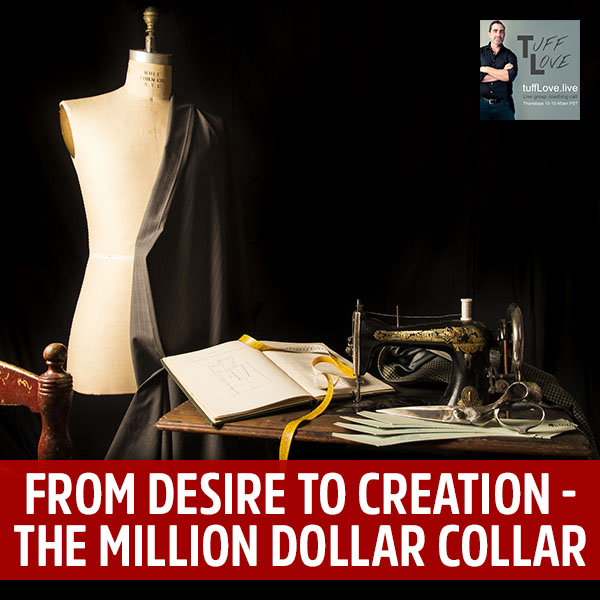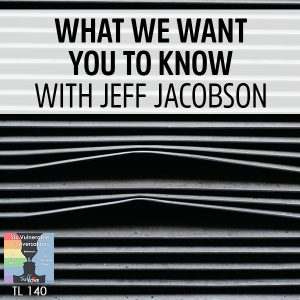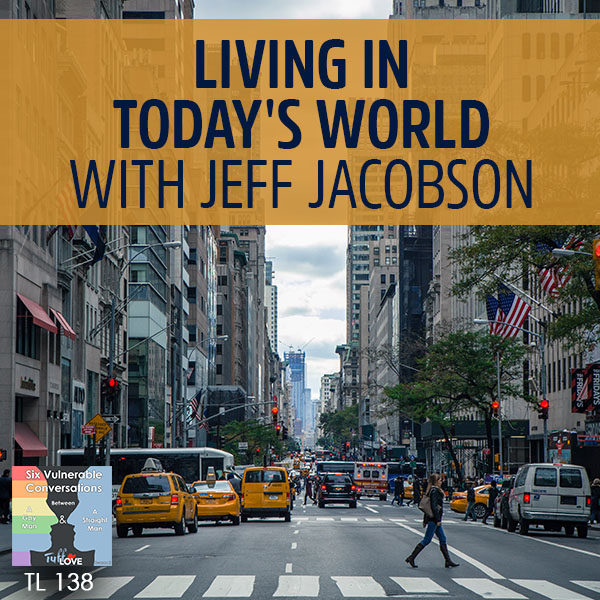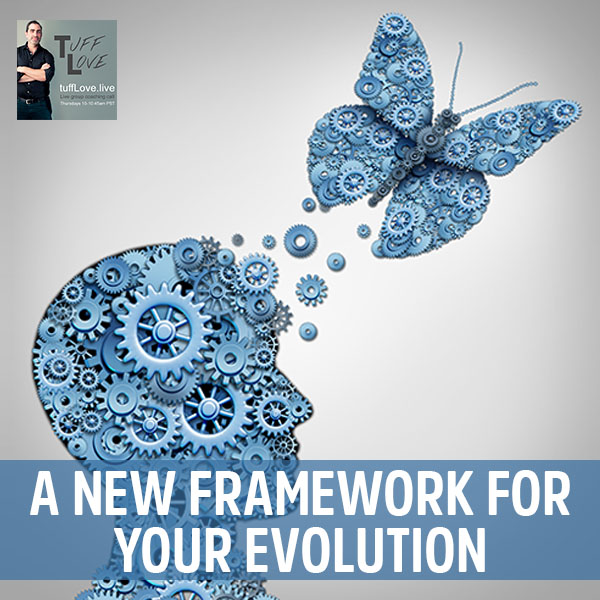
139: From Desire To Creation: The Million Dollar Collar with Rob Kessler
Jun 5, 2018
After Rob Kessler’s wedding, he looked at the day’s photograph and was unhappy with how he looked. He described himself “looking like a beach bum”. Inspired, he started to look on the internet for the ideal shirt to no avail. Most people at this point would have given up. Instead, Rob created the “Million Dollar Collar” and has over 150,000 sales after two years. He is now known as the No Tie Guy after inventing the most dramatic enhancement to collared dress shirts in the last 70 years. His mission is to give men an alternative to the unbuttoned, sloppy dress shirt look. Rob combined his experience as a businessman and knowledge of the clothing manufacturing process to help make men more comfortable and stylish with a staple clothing item. Listen to his story about how he came up with the product and the success of being an entrepreneur.
—
This episode is with Rob Kessler of Million Dollar Collar. I’m excited to have him to tell the story about him as an entrepreneur, what he’s learned, how he’s done it, and his inspiration to keep creating, keep innovating and how to bring a product to market. Rob is an interesting guy. If you feel so inclined, please subscribe via your favorite podcast app, Stitcher, iTunes and the like.
139: From Desire To Creation: The Million Dollar Collar with Rob Kessler
We have another amazing guest, a man named Rob Kessler, the no-tie guy. He’ll be talking about his process being an entrepreneur. He’s had a very interesting career that I’m excited to dive into and talk about. As an example, moving from what I call the creative into reality. Rob Kessler is the Inventor and Co-Founder of Million Dollar Collar, a relatively simple solution to fix what his company dubs Packettitus, which is the shrinking, wrinkling and folding of the packet of the casually worn dress shirt. Prior to Million Dollar Collar, Rob built a screen printing embroidery business in his spare bedroom to over a million-dollar business before starting the company. Although this company was never intended to be a screen printing company, its work soon got up a high quality, great pricing, never missed a deadline guarantee. Rob’s sales experience and number of high-dollar industries including diamonds, real estate and automotive sales provide a unique blend of backgrounds. Welcome, Rob. It’s great to have you on.
How are you?
I found you through a system called PodcastsGuests.com, which you’ve listed or your PR company listed. I looked through probably ten, fifteen, twenty per week and there’s something about you that caught my eye. I was intrigued about your process of go-getter or an entrepreneur. As an entrepreneur myself, I know the challenges in terms of relationship and intimacy and myself as a man, my self-worth, and you definitely keep looking and keep inventing new challenges to live your life. I’m excited to talk to you about your life history and your process, so welcome to the show.
Thanks. I get bored easily, so that’s why it’s been so all over the board but it all makes sense in the end.
There’s ADD and ADHD, all of these things that people are saying that are attention deficit disorder but there are people like us who just need constant stimulation. Have you been like that your entire life of just needing new toys and concepts?
I always remember getting a new job and it would be the most exciting time because I’m absorbing as much information. It’s scary as hell because there are all these people that you don’t know and you don’t want to do things wrong, but at the same time it was always so stimulating to learn how to sell a car and going to that training and real estate and getting my license. I was one of the fastest people in the state of Wisconsin to ever get their license, from opening the book to pass my test in ten days. When I find something I love, I dive all-in and I’m a totally immersion guy. If I get into it and I turned out to hate it, then it will get passed aside and I’ll never think about it again, but stuff that I love, I find something I really love and I just became a captain. I got my captain’s license for boating. Add that to the list of crazy things I’ve done.
There are positive attributes to this virtue of you, success and motion and ten days to get to real estate license. That sounds ridiculously fast. Do you feel like there are detriments or parts of you that this behavior has a negative impact?
I don’t think it’s negative. I came from my dad. My dad owns jewelry stores in Wisconsin. I was working for him in college and he sat me down one day and said, “If you’re ever going to run this company, you can’t do it from the inside out. You can’t have only done this thing and expect to be able to revolutionize and grow as things change.” He was the one that encouraged me to go out and do other things so I could bring back to the table different ideas and outside thoughts other than what he had built in his company. It was a great inspiration and it helped me to spread my wings and do some different random things. I loved all of them for different reasons.
Are you heading back to the jewelry business at some point?
I did it in college then for two years after college. Then I left. I did real estate. I did cars right away, then I did real estate. Then I did the screen printing business. As the real estate market was tanking in 2008, 2009, he had a long-term employee that was retiring. The timing was good, so I came back and worked for another couple of years and became one of the top salespeople. It turns out that we are better father and son than we are employer and employee. I’m probably a little bit too much like him, which I was probably a little stubborn and frustrating for him. We decided to be father and son instead of employer-employee. That’s when I went off. I grew the screen printing business and kept my real estate license on the side. While I was doing the real estate and screen printing, I met my wife, my shirt was a mess and that’s when Million Dollar Collar came about. I had three things going at once, once I started Million Dollar Collar.
Congratulations on being aware of the father-son relationship being healthier than the employer-employee. Some men or some people would want to follow with the setup of the jewelry and live a life that doesn’t quite work for them. How did you come to that conclusion? Was that a tough decision or was it mutually easy?
It wasn’t easy at all. His company is his baby and I understand that now with Million Dollar Collar because my wife and I sometimes don’t always agree. I tend to take it personally. It’s not her fault. It’s my baby, it’s everything I’ve worked for. I didn’t approach my dad typically always right, so when I have an idea, it’d be like, “Your thing sucks and my idea is great.” He’s like, “Suck it. You don’t know what you’re talking about.” We battled pretty hard for a while and it was getting taxing. There were times when we wouldn’t speak for weeks or months, which is tough when he’s in the same building and we’re working together. It got to a head and we were just like, “Let’s not do this anymore,” so I went off and did my own thing. Then a few years later, I ended up moving here to Los Angeles, so it’s not an option anymore since he’s in Wisconsin and I am not going back to that cold.
What do you think makes a good salesperson? How did you achieve success with the jewelry and in the car and the real estate? What factor is inside of you that needs to come out and developed to be successful?
Sales, anybody will tell you it’s not about selling, it’s about listening. I remember in real estate, I’d have friends be like, “This is the style of house I want. I want this and this.” I remember this one couple, I’m still dear friends with them, I probably showed them twenty or 30 houses that they thought they liked. Finally, I said, “It’s my turn. We’re going to do a tour of homes that I picked that I think that you guys will make money on it and I think that you’ll like.” They ended up fighting over two houses from that list. It was listening to what they wanted. They see a picture and like, “We want this.” I knew as soon as we got through the house, it wouldn’t be something they want. The same thing with diamonds. My dad’s company is focused exclusively on engagements, diamonds and diamond engagement rings. That’s a real relationship thing. You find out about how they met, how he was going to propose, what style she liked. It’s a lot of trust. There’s a lot of distrust in the jewelry industry and in the car industry. To overcome that, you have to build a relationship with somebody. That takes listening to get there.

Million Dollar Collar: If you want to make something work, you have to be obsessive about it.
Sounds like it takes time and patience and waiting for the right time for that bond and trust to be built.
You can’t rush it. I have a good friend of mine that I probably showed her houses for two years before she finally bought something. Some processes are longer than others. There’s always stuff going on, so you don’t need to have that one sale that day. Everything I’ve had has always been a longer process sale. Million Dollar Collar is the same way. It’s takes time.
My real estate agent when I bought my house in San Francisco about 150 years ago, she was a casting director. She worked in theater and she’s like, “We’re going to cast you into the house. We’re going to have the right set for you for your next part of your action.” She did a good job. She found the right house.
Being in real estate, a lot of people think that it’s just I show you houses. It takes a little bit of selling. It takes a little bit of, “Here’s what’s good about this and here’s not what good at this.” No house is perfect and if I walked into a house that I didn’t change a thing, it would freak me out that somebody else out there wants exactly like me. Even if it looked perfect, I would paint a wall or change the flooring or do something. Buyers will always tend to find the craziest random reasons to try to not buy something and it’s like, “Let’s be serious here. Let’s get you down the road.”
Avoiding that buyer’s remorse problem. They’re nervous about that part. Million Dollar Collar, the story goes that you were getting married and your shirt was a mess. Did I perceived that right in the pictures?
I met my wife on the beach in Milwaukee and we got married on the beach in Jamaica. I’ve never been a tie guy. It probably comes from my car sales days when I was forced to wear one all the time. I never liked wearing them. I think they’re restrictive and styles just away from the tie. Studies show that 90% of dress shirts will rarely, if ever, be worn with the neck tie. That’s just how I am. I own one tie just in case. I went to Magic Castle recently and had to dig through a bin and try to find a tie because it’s required. I wasn’t going to wear a tie on my wedding day. It’s just not who I am. I had a brand-new freshly pressed shirt. It’s Express 1-MX. Before I even said I do, it was tucked under my lapel. I looked terrible. I’m looking at the wedding photos from the biggest day of my life and I thought I looked like a bum. I hated the way that my shirt looked. I remember tugging at it all day trying to get it to sit where it was supposed to sit, and it wouldn’t do what I needed to do.
As soon as I came home, I cut open a dress shirt, I took a piece of cardboard, I shoved it down into the placket, which is where the buttons in the button holes are, because to me, that’s the part that crumbles and folds. I shoved this cardboard down and as much as I explained it to my new bride, when she saw it, she was like, “I get it. Finally, I understand what you’re talking about.” It started with cardboard and then I went through my house. Every piece of plastic I could find, milk cartons, mini blinds, zip ties, flexible cutting boards, any plastic I could find in my house I was testing. I would wash and dry a shirt and then I’d send it to the dry cleaner and it would just get trashed into my room, probably 100 shirts figuring it out, which is why it took three years to get right. I knew that it had to go in here because this is what was broken. Collar stays were invented in 1888. That was fixed 150 years ago, so that wasn’t the problem. It’s down here.
Some people would think you’ve got a little obsessive about this thing, working three years and cutting out shirts. I don’t know if your wife ever thought you’re a madman trying to figure this piece out. It felt like, “I need to figure this thing out.” How did you handle the critic either internally or externally to keep going to figure this out?
Anybody’s obsessive. If you look at Jeff Bezos or anyone that’s highly successful, and I am by no means highly successful, but if you want to make something work, you have to be obsessive about it. When I find something that I’m into, I dive. I’m all-in, I want full immersion. It took three years because I was running two other companies at the time. I was doing the screen printing, I was still doing real estate, my wife and I own a commercial building and our duplex, so there’s always stuff to do there and she probably had a social life a little bit. It took time, but if you saw the prototypes and the designs over these three years, you’re like, “How did you get there? What was the thought in that process?” We have made some preproduction dress shirts in India, so I was dealing with overseas shipping stuff. You have to be obsessive if you’re going to find the right solution and with many dress shirts, brands and designs come up with a universal design. I had to ask every friend I could for a shirt just to play with and test and it takes time.
I understand the obsessive compulsive. I have a similar feel to it. When it comes to clothes, I feel like I’m a little lazier and a little more absent-minded professor, my wife, Morgan. She is often fixing things, but I can feel it. I can feel the passion behind it. You want to solve the problem, you needed to solve the problem, but during solving the problem, did you see it as a business? Did you see it as you wanted to do something? What was the flavor, especially the initial part?
I’ve had other ideas that I haven’t pursued, and I’ve regretted that I haven’t pursued those ideas. I felt like I’ll start with myself. I have shirts in my closet, let’s get those fixed first and then I have a circle of friends and we’ll talk to them and see what they like. Ironically enough, my business partner was the one I probably had the hardest time convincing that this was something that could be something a lot bigger. He left a really high paying job to do this full-time. I finally convinced all the way, but, it’s tough. It’s challenging. When you’re in that process and you make a little bit of progress, you’re like, “That’s good enough.” My wife would be my biggest critic because if you’re going to put something out, you want it to be right. I put so much energy in. I was trying to make something work a couple of times and thank God her and Steve, my partner, were like, “This isn’t good enough. Let’s keep going.” That contributed to the time timeframe as well.
It’s smart of you to listen to the woman. It’s always smart to listen to the woman. When did you come up with your final product? Was it three years into it?
We did a Kickstarter. I was like, “Let’s go full board ahead. Let’s jam and let’s get this thing going.” We had these pre-production samples. We hadn’t even totally finalized, but we ran the Kickstarter like a lot of kick starters do. We thought, “We’re going to make dress shirts, we’re going to offer this unique selling proposition, it’s going to be our differentiator.” We didn’t get funded. We raised about $16,000 of the $40,000 goal we had and it turned out to be the biggest blessing in disguise. Unequivocally the feedback was, “Why are you trying to compete with every other brand and why can I upgrade the shirts I already owned?” After we had done that, it was back to the drawing board to redesign the thing all over again. As an entrepreneur, you have to be able to pivot and listen to what the market is telling you.
If you get such tunnel vision that, “This is my idea, I’m going to go through and I’m going to do it my way,” the chances of being successful minimize because you’re not listening to what your customers are telling you. We pivoted, I totally redesigned it. I simplified and streamlined it. I was checking every dress shirt I could try to make sure that it would fit. It took, by that time, it was about two and a half years. My wife and I moved, sold everything we had. We sold the screen printing business, we sold our second car, we sold our furniture, everything we had. We moved to Los Angeles and went all-in. On our ten-day cross-country move is when the patent attorney called and said it was approved. While we had sold and we’re going to go all-in, we got the confirmation that we’re on the right path. That was pretty awesome.
Are you thinking like a Shark Tank? Do you ever think about going in that direction?
I would totally do Shark Tank. The problem is 60,000 people apply every year and 225 are filmed and only 150 of those air. The odds are just massively stacked against you. We apply, we’ve done video application, we’ve gotten far into the process. To me, it’s like a lottery ticket. You get the most amazing, ridiculous exposure and you better be ready to handle it. When we did our last round of interviews, we were newly launched, a couple months old, and we weren’t ready. We would get slaughtered and end up hurting us more than anything. If they came calling, you bet I would definitely jump on board.
Let’s talk about the patent process. What was the motivation to get a patent and what was your process?
I knew that it was something different. I searched the internet, it wasn’t out there shockingly. I hear all the time like, “Seriously, nobody’s thought of this. I wanted to make sure that I was protected. If I was going to throw my whole life behind this product, this idea, this company, I wanted to have a least some protection.” A friend of mine from high school is an attorney. He referred me to a patent attorney in town and we started that process and it is expensive as hell and it’s super frustrating. The first thing you’ll do is a patent search and it’s probably anywhere from $1,500 to $3,000 for them. You can Google all you want, but those guys will dig deep into reading patents, seeing if you’re going to infringe on any before you even progress.
You’re writing a huge check to start. It seemed like every single month it was like, “It didn’t matter what I did or said there, was another thousand or $2,000 bill in the mailbox.” We did the patent search first, then you write it, do a provisional patent, which protects you, get you in line. Patent pending is next. Then the final patent approval after you write that first a check, the next one is to the government saying, “Would you like to expedite this service?” Expediting means they respond to you in six weeks instead of six months. That costs an extra $3,500 right up front. It took us almost three years to get the patent expedited. The challenge is your attorney is going to write it this big and the government wants to see it this big. It’s just this back and forth and back and forth because you want to protect as much as possible and they want it as big as possible. Every time that goes back and forth, that’s how many thousands, how many zeroes on that check. It’s expensive and time consuming.
Do you feel like your project, this shirt, have a social implication for you? Did you want to solve a problem? All of us want to serve the world and want to make things better. Do you have an underlying something in terms of your product?
Image is a big thing. Anybody who says that they don’t judge a person when they see him ten feet away walking towards them is lying to themselves. If you’re in that world and you care about the way that you look, which I do enough, that’s where it started. I don’t typically wear a dress shirt. I don’t wear them every day because I love wearing dress shirts. I wear a dress shirt when I want to step up and look a little bit nicer. Typically, you’ll see me in a V-neck. I wear t-shirts and I sit at my desk, which is five feet away in my living room, so I don’t even dress up for anybody but if I’m going to, I want to put on a dress shirt. To me, if this side is down like this and this side is up, it’s not a good presentation and it doesn’t represent me who I am. That’s where it started. Beyond that, when you have success and you can be financially more independent and flexible, then you can start supporting people. You can help other people. To me, that’s where the real success comes, when I get a chance to lend a helping hand that I wasn’t necessarily able to or can now.
There are a lot of books out there, a lot of articles out there, and truly the impression does matter first. As much as we don’t want to think we’re visually oriented, we really are. The human eye picks up all these little details, all the little things that we don’t pay attention to, so it is a service and it is good to look good if that’s the impression you want to make out there in the world.
Everybody’s different. Some people don’t care and that’s fine. If you do care and you are going to put on a dress shirt, you want to dress up a little, this is the one little accent. A lot of our customers comment back and like, “This final little detail makes such a difference.” It’s the craziest thing and once you experience it then you totally get it. Just like my wife sitting on the couch with that piece of cardboard and my shirt that was still half open, she got it because she can visually see what the differences are.

Million Dollar Collar: When you have success and you can be financially more independent and flexible, then you can start supporting people.
What does your wife think about this project and now that after all that’s written, we’re all in three years and the R&D. What’s your impression?
We’re still growing. It never happens quite as fast as you’d like it to, but we’re at a tipping point. We’ve had some great sales to this point. We’ve shipped 155,000 units to people in 92 countries, which I never thought that I would be doing that. We’re talking to some big retailers. We’re talking to tons of dry cleaners to help them grow their business. We’re at that tipping point. We live in an 800 square foot apartment, so we’re not doing it. She’s a stunt woman, so she gets to do what she loves and it’s pretty amazing. We’re making it work. She’s supportive.
Is this your project? You have another one in line coming down the line, but if you can imagine your brand?
I’ve got an idea for another patent, but I need to get this one going. I haven’t even filed a provisional for that one because I want to stay focused. My mind is always going, I’m always sitting in a situation and like, “If it was this way, that would work better. Why don’t they make it like this?” That’s just how my mind works.
Thank you so much for coming on Tuff Love. You have a special offer for the audience and maybe you can give the website and how people can order your product and the discount code.
It’s easy to order. We’re MillionDollaCollar.com. If you use TF15, you’ll get 15% off your order. We’ll add that discount code in. We ship internationally. Amazon, if you need it quick. You won’t get the discount code but we’re available on Amazon, US, UK, Canada, Japan and rolling out to the other ones. We’re on social media, @MillionDollarCollar, that’s easy to find as well.
Thanks so much, Rob, for coming to the show.
Thanks for having me.
Thanks so much for joining us for Tuff Love, different show. I like to keep things up and coming. I’m grateful to Rob for sharing a story and all the entrepreneurs out there knowing and the salespeople. I like the concept of taking time, patience. It’s never going to be as fast as you think it is. In the end, follow your dreams and take those vests are really the stuff of life for me and helped me be. Thank you so much. Thank you so much for joining us. Take care.
Thank you, Rob, for being on the show. I enjoyed listening to your story. Much success to you and your new product. For more shows, please visit TuffLove.live. We’d love if you’d subscribe via your favorite podcast app and for the double triple bonus, please give us a review. Send us some stars. We’d most appreciate it. Thanks so much. Enjoy the day and I’ll talk to you soon.
Resources mentioned:
- Million Dollar Collar
- PodcastsGuests.com
- MillionDollaCollar.com
- @MillionDollarCollar – Facebook
- Tuff Love on Stitcher
- Tuff Love on iTunes
About Rob Kessler
 Rob Kessler, a.k.a. the No Tie Guy, invented the most dramatic enhancement to collared dress shirts in the last 70 years. His mission is to give men an alternative to the unbuttoned, sloppy dress shirt look. The brilliantly simple product, called Million Dollar Collar, reinforces the placket of any dress shirt, forever preventing it from collapsing into a sloppy mess under the weight of the collar. He has experience as a businessman, knowledge of the clothing manufacturing process and has a desire to help make men more comfortable and stylish with a staple clothing item. Kessler created and executed an in-genius fashion product that often has people think, “why didn’t I think of that?“
Rob Kessler, a.k.a. the No Tie Guy, invented the most dramatic enhancement to collared dress shirts in the last 70 years. His mission is to give men an alternative to the unbuttoned, sloppy dress shirt look. The brilliantly simple product, called Million Dollar Collar, reinforces the placket of any dress shirt, forever preventing it from collapsing into a sloppy mess under the weight of the collar. He has experience as a businessman, knowledge of the clothing manufacturing process and has a desire to help make men more comfortable and stylish with a staple clothing item. Kessler created and executed an in-genius fashion product that often has people think, “why didn’t I think of that?“
Podcast: Play in new window | Download







